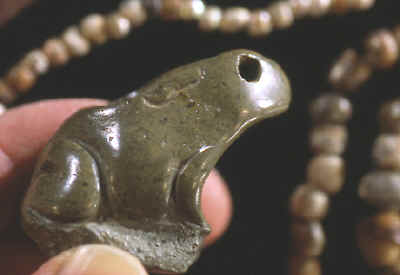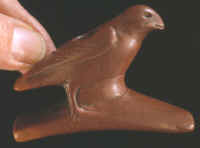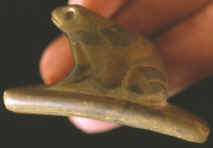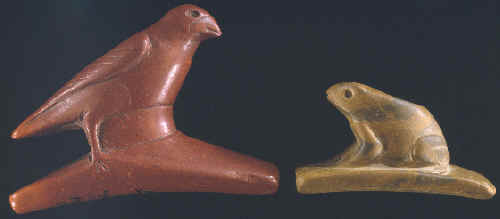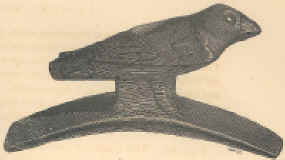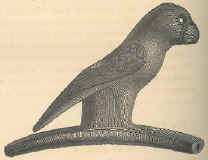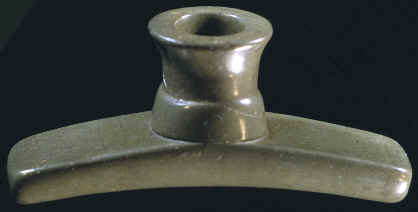|
HOPEWELL
PLATFORM EFFIGY PIPES |
|
|
Looking a little worse for wear but still showing a lot of artistic strength. This Hopewell pipe is missing both sides of its platform and the pearl inlayed eyes that once made it sparkle. These rare Hopewell effigy pipes were made by skilled craftsmen around 2,000 years ago. The beads in the background are freshwater pearls from the Ogden- Fettie Hopewell site in north central Illinois.
The bird effigy pipe on the left was found in the middle 1800's in Madison County, Illinois. The Frog effigy pipe on the right was found in Calhoun County, Illinois by Mrs. Wadlow in the 1950,s. Both of these Hopewell Platform Effigy Pipes represent a category of artifacts that have been highly prized by the academic community and collectors ever since the first examples were excavated from Hopewell burial mounds in the eastern United States. The Smithsonian Institution illustrated and described dozens of examples in their first publication over a 150 years ago. They were very impressed with them then just as people are today. As an example (fig.#164 pipe, page 259) "As a work of art it is incomparably superior to any remains of the existing tribes of Indians". Hopewell pipes are certainly some of the most impressive anciently carved and polished Stone Age artifacts ever found in North America.
Some of the finest carved
and polished stone work done by native Americans before European contact
in North America was achieved during the "Golden Age" of the
Middle Woodland Period. These two pipes are "classic" examples
from that time. They appear to be studying each other in this picture.
Try to envision them with their original fresh water pearl inlayed eyes.
These two Hopewell platform pipes are illustrated in the first publication printed by the Smithsonian Institution over 150 years ago in 1848 called "Ancient Monuments of the Mississippi Valley" by E.G. Squire and E.H. Davis. This early book illustrates at least 40 Hopewell culture pipes. Most of which are probably from Ohio. They write "the sculptures of birds are much more numerous than those of animals (mammals & reptiles), and comprise between 30 and 40 different kinds (of birds) and not far from one hundred specimens (pipes in the collection)".
This Ohio Hopewell bird effigy pipe is broken and the surface is pitted from weathering but it still retains much of its original majestic image.
This platform pipe is a good example of the plain style of Hopewell pipes. Most Middle Woodland pipes were not effigy pipes. The majority are round bowls on a drilled stem platform. This pipe is made of green Ohio pipestone.
|
|
| CONTINUE ON TO PAGE TWO | |
|
"REFERENCES"
|
|

